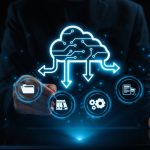AI-Driven Automated Cloud Migration
🚀 AI-Augmented AI-Driven Automated Cloud Migration: The Next Evolution in Enterprise Modernization
🌐 Introduction
Cloud migration has become a cornerstone of digital transformation, but traditional methods—manual discovery, static assessments, and semi-automated refactoring—are no longer fast or flexible enough. Enter: AI-driven automated cloud migration, a paradigm that uses artificial intelligence to streamline planning, execution, and optimization.
But now, we’re witnessing the rise of an even more advanced layer: AI-Augmented AI-Driven Cloud Migration—where AI agents enhance, supervise, and even train other AI systems for smarter, faster, and more resilient migrations. This dual-AI model marks a radical leap toward autonomous cloud modernization.
🤖 What Is AI-Augmented AI-Driven Cloud Migration?
AI-driven cloud migration automates core processes:
Discovery of on-prem infrastructure
Dependency mapping
Cloud suitability assessments
Migration planning
Code refactoring
Cost and performance optimization
AI-augmented migration takes this further by using AI to improve AI. Imagine an LLM-powered assistant that:
Tunes migration algorithms in real-time
Self-learns from past migration outcomes
Assists AI agents with contextual understanding of business goals
Performs meta-analysis of migration performance and adapts accordingly
It’s like having a senior AI engineer mentoring your AI migration team—at machine speed and scale.
🧠 Key Components
1. Multi-Agent Systems
Autonomous AI agents collaborate on different migration stages.
Augmenting agents evaluate outputs from migration agents and optimize their behaviors.
Tools: AWS AgentCore, Azure Arc’s Continuous Assessment, Google Duet AI
2. LLM-Augmented Reasoning
LLMs (like GPT-4o or Claude) act as copilots: summarizing configurations, recommending policies, rewriting legacy code, and interacting in natural language.
Context-aware agents align technical execution with business KPIs.
3. Feedback Loops & Self-Tuning
Real-time monitoring generates feedback for AI agents.
Meta-AI layers analyze outcomes and adjust strategies on the fly (e.g., retrying with alternate migration paths when failures occur).
4. Data-Driven Governance
AI systems track compliance, governance, and risk indicators.
An AI governance agent ensures security and regulatory alignment throughout the migration lifecycle.
🔍 Use Cases in 2025
🏢 Enterprise App Modernization
A Fortune 500 retailer migrated 5,000+ .NET and Java applications using AI agents that automatically refactored code and optimized storage tiers with 92% success rate on first deployment.
💰 Cost Forecasting + Auto-Remediation
Cloud cost AI predicts overspending and reconfigures cloud instances via policy-driven automation—AI watching over AI.
🧪 Legacy Tech Migration
Mainframes and VMware workloads are auto-containerized and deployed to Kubernetes clusters with AI-augmented container sizing.
🧭 Challenges and Considerations
Challenge
Complex dependencies
Legacy code quality
Human oversight
Security risks
📈 Future Trends (2025–2027)
Auto-Pilot CloudOps: AI agents handling entire DevOps pipelines post-migration.
Quantum-assisted planning: Quantum AI for large-scale migration scenario modeling.
Domain-specific copilots: Finance, healthcare, and manufacturing-focused AI migration copilots.
Zero-downtime self-healing agents: AI that predicts and corrects post-migration errors before users even notice.
📝 Conclusion
AI-Augmented, AI-Driven Cloud Migration represents a shift from intelligent automation to AI orchestration. By embedding multiple layers of AI—agents that reason, learn, and adapt in real-time—enterprises gain a powerful framework to reduce costs, accelerate timelines, and ensure more reliable migrations.
This isn’t just about moving workloads—it’s about evolving how IT itself operates. As we look ahead, the enterprises that embrace this AI-Augmented revolution will be the ones redefining operational agility and digital excellence.
🔧 Ready to Migrate?
Whether you’re planning a large-scale cloud migration or modernizing a handful of legacy apps, consider leveraging a multi-layered AI strategy. The era of AI augmenting AI isn’t just here—it’s the new standard.





